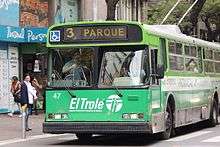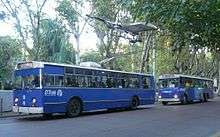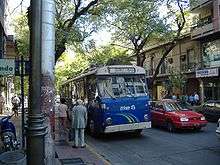Trolleybuses in Mendoza
 An ex-Vancouver Flyer trolleybus in Mendoza in 2014 | |
| Operation | |
|---|---|
| Locale | Mendoza, Argentina |
| Open | 14 February 1958 |
| Status | Open |
| Routes | 6 |
| Owner(s) | Province of Mendoza |
| Operator(s) | Empresa Provincial de Transportes de Mendoza (EPTM) |
| Infrastructure | |
| Electrification | 600 V DC |
| Website | Empresa Provincial de Transportes (Spanish) |
The Mendoza trolleybus system (Spanish: Sistema de trolebuses de Mendoza) is part of the public transport network in Mendoza, the capital city of Mendoza Province, Argentina.
Opened in 1958, the system presently comprises six lines, which link the city center with some of its metropolitan suburbs.
History
The system traces its origins to law number 825, enacted in 1958 with the goal of making a trolleybus system one of the main means of transport in the city and the suburbs surrounding it.[1]
On 14 February 1958, at the intersection of 9 de Julio and Necochea streets, Dr. Isidoro Bousquet formally opened Mendoza's trolleybus system.[2] The first line to be put into service by the system's operator, the Empresa Provincial de Transportes de Mendoza (EPTM), was the "Parque" line, also known as line number 1. To this day, that line still follows the same route (9 de Julio, Colón, Arístides Villanueva, Boulogne Sur Mer, Jorge A. Calle, Perú and Godoy Cruz streets).[1] The system's second line, "Villa Nueva", opened in February 1959 and the third, "Dorrego", in March 1961.[3] Publicly, the routes were designated by names only, not numbers, and this practice continued until the mid-1990s.
The Mendoza trolleybus system has grown in recent years, with the construction of a long new line connecting Godoy Cruz with Las Heras, and of a shorter line connecting the bus terminal with the National University of Cuyo. These opened in April 2004[4] and October 2005,[5] respectively. The Las Heras – Godoy Cruz line is 15 km (9.3 mi) long.[4] In November 2013, an extension of the Dorrego route was opened.[6]
Lines
The system currently has six lines:
- 1 – Parque (Park): A large one-way loop that includes Avenida Boulogne Sur Mer (including the 'Portones', the entry to the General San Martín Park), the city center (Avenida 9 de Julio and Avenida Colón) and Avenida Aristides Villanueva
- 2 – Villa Nueva: Connecting the city center with the Villa Nueva district, to the east, in Guaymallén Department
- 3 – Dorrego: Connecting the city center with the Dorrego district, in Guaymallén
- 4 – Pellegrini: From the city center to Barrio San Martín, to the northwest, via Calle Pellegrini and other streets
- 5 – Godoy Cruz–Las Heras: connects three Mendoza's Departamentos (administrative divisions): Godoy Cruz, Capital and Las Heras, mostly along the arterial street, Avenida San Martín
- 6 – UNCuyo: Connecting the Universidad Nacional de Cuyo (UNCuyo) with the city center
Fleet
Current fleet


The replacements for the TS vehicles were 80 secondhand Flyer E901A/E902 vehicles from the Vancouver trolleybus system in Canada, which were built in the early 1980s.[8] They began to arrive during December 2008,[9] and all 80 had arrived by February 2009.[10] After being refurbished, repainted and renumbered in Mendoza, they began to enter service on 30 April 2009.[11] By June 2010, 60 had been refurbished and repainted, and 40 had entered service.[12] The repainting involved five different liveries, all with the colours laid out in the same pattern, with each version given to 12 vehicles (in the first 60).[7] They were renumbered from their four-digit Vancouver fleet numbers into the series 01–60.[7]
The Flyer vehicles were intended to allow the EPTM to improve trolleybus services, and to operate extensions of new lines that were already in service. However, by 2011, EPTM had already begun to experience problems maintaining the Flyers,[13] due in part to their age (about 30 years) and in part also to the loss, during shipment, of maintenance manuals and a crate of spare parts shipped from Canada in 2009.[7] In December 2011, more than one-third of the Flyer trolleybuses were reported to be out of service due to chronic maintenance problems.[14]
EPTM began to consider acquiring all-new trolleybuses, and ultimately partnered with Materfer, an Argentine manufacturer of railway vehicles and buses, to construct a prototype low-floor trolleybus. EPTM designed the new vehicle, and Materfer built it.[15] It was delivered on 1 March 2013[15] and entered service on the Mendoza trolleybus system on 7 June 2013.[16][17] Numbered 401, it was the first low-floor trolleybus built in Argentina and EPTM's first all-new trolleybus since the mid-1980s. Its body and chassis were built by Materfer, and its electrical equipment by Siemens, but the latter was replaced by equipment from Schneider Electric later in 2013.[6] EPTM placed an order in July 2013 for 12 more Materfer/Schneider trolleybuses,[16] and the first two were delivered in April 2014.[18] These new trolleybuses are 11.23 metres (36.8 ft) long.[18] Six Materfer trolleybuses had entered service by October 2014, numbered 401–406.[19]
Past fleet


Mendoza's initial trolleybuses were a fleet of Mercedes-Benz units bought secondhand from the Buenos Aires trolleybus system, with a final total of 25 being acquired by 1960.[3] However, these were soon replaced by a fleet of 36 Japanese Toshiba vehicles, built new in 1962. All of the Mercedes-Benz trolleybuses were already retired by the end of 1963.[3]
In 1984, the system acquired 17 new ZIU-9 trolleybuses from the Russian Uritsky factory.[3] In 1988, EPTM began replacing the remaining Toshiba vehicles with secondhand trolleybuses that had previously operated on the Solingen trolleybus system in Germany. EPTM acquired 78 of these German trolleybuses, known as Trolleybus Solingen (TS) buses and, in stages over the next several years, put 58 of them back into service.[20]
The remaining 20 TS vehicles were used initially as spare parts donors. However, due to a network expansion in about 2005, even more TS vehicles were reactivated. All of the TS trolleybuses originally kept their Solingen fleet numbers, except with a "0" added before the fleet number in the case of two units whose Solingen numbers were the same as the number of a still-active ZIU trolleybus. However, at the beginning of 1996 they were renumbered into a new, continuous series. In 1997 they were reliveried in blue. Due to their German origins, they were also known in Argentina as los alemanes (the Germans). TS vehicle no. 37 was given a special task. For a time, it was used for tourist sightseeing tours, with a revised interior design and a special livery.[21]
The last five serviceable ZIU trolleybuses were retired in January 2009 and were sold in September to the Córdoba trolleybus system.[22]
From April 2009, Mendoza's TS trolleybuses were successively replaced. By early March 2010, there were only eleven TS vehicles still in use. Their final operating day was 1 May 2010.[23] A German group, the Obus-Museum Solingen e. V.,[20] helped to secure the return of one of the TS trolleybuses to Germany, for preservation. No. 51 (ex-Solingen 68) was chosen in 2011, and it was transported back to Solingen in 2014.[19]
See also
References
- 1 2 Bohé, Luis (2005). "Los trolebuses de Mendoza" [The trolleybuses of Mendoza]. Colectivosdemendoza.com.ar website (in Spanish). Retrieved 17 September 2011.
- ↑ "Feliz 51º Aniversario E.P.T.M" [Happy 51st Anniversary, E.P.T.M]. Trolebuses Mendocinos blogspot (in Spanish). 14 February 2009. Retrieved 17 September 2011.
- 1 2 3 4 Morgan, Steve (May–June 1987). "Expansion in Mendoza". Trolleybus Magazine No. 153, pp. 58–63. National Trolleybus Association (UK). ISSN 0266-7452.
- 1 2 Trolleybus Magazine No. 256 (July–August 2004), p. 90. National Trolleybus Association (UK). ISSN 0266-7452.
- ↑ Trolleybus Magazine No. 265 (January–February 2006), p. 12.
- 1 2 Trolleybus Magazine No. 315 (May–June 2014), p. 72.
- 1 2 3 4 Trolleybus Magazine No. 297 (May–June 2011), p. 63.
- ↑ Sinoski, K. (11 September 2008). "Aged trolleys sold to Argentine city". Vancouver Sun. CanWest MediaWorks Publications Inc. Retrieved 17 September 2011.
- ↑ "Los troles de Canadá empezaron a llegar" [The Canadian trolleybuses begin to arrive]. Los Andes (in Spanish). 7 December 2008. Retrieved 17 September 2011.
- ↑ Trolleybus Magazine No. 285 (May–June 2009), p. 59.
- ↑ Trolleybus Magazine No. 286 (July–August 2009), p. 85.
- ↑ Trolleybus Magazine No. 293 (September–October 2010), p. 110.
- ↑ Fayad, Federico (18 November 2011). "Los troles canadienses, rotos y sin repuestos" [The Canadian trolley, broken and no spares]. Los Andes (in Spanish). Retrieved 4 April 2015.
- ↑ Trolleybus Magazine No. 302 (March–April 2012), p. 40.
- 1 2 Trolleybus Magazine No. 309 (May–June 2013), p. 72.
- 1 2 Trolleybus Magazine No. 311 (September–October 2013), p. 128.
- ↑ Budach, D. (22 July 2013). "Mendoza [AR] - In Service, More Orders Expected". TrolleyMotion. Retrieved 4 April 2015.
- 1 2 Trolleybus Magazine No. 316 (July–August 2014), p. 100.
- 1 2 Trolleybus Magazine No. 318 (November–December 2014), p. 154. National Trolleybus Association (UK).
- 1 2 "Projekt "TS"" [Project "TS"]. Obus-Museum-Solingen eV website (in German). Obus-Museum-Solingen eV. Archived from the original on April 2, 2012. Retrieved 17 September 2011. External link in
|work=(help) - ↑ Budach, D. (15 March 2010). "Trolleybus News: Mendoza (AR) - Das Ende der ex-Solinger steht bevor!" [Trolleybus News: Mendoza (AR) - The end of the ex-Solingen vehicles is imminent!] (in German). TrolleyMotion. Retrieved 4 April 2015.
- ↑ Trolleybus Magazine No. 289 (January–February 2010), p. 12. National Trolleybus Association (UK).
- ↑ Budach, D. (10 May 2010). "Trolleybus News: Mendoza (AR) - Das Ende der ehemaligen Solinger Dreiachser" [Trolleybus News: Mendoza (AR) - The end of the ex-Solingen three-axle vehicles] (in German). TrolleyMotion. Retrieved 4 April 2015.
External links
![]() Media related to Trolleybuses in Mendoza at Wikimedia Commons
Media related to Trolleybuses in Mendoza at Wikimedia Commons
- "Trolleybus city: Mendoza". Trolleymotion.
- Mendoza database / photo gallery and Mendoza trolleybus list at Urban Electric Transit – in various languages, including English.
This article is based upon a translation of the Spanish language version, and of part of the German Wikipedia article Trolleybus Solingen, as at September 2011.
Coordinates: 32°53′S 68°49′W / 32.883°S 68.817°W
